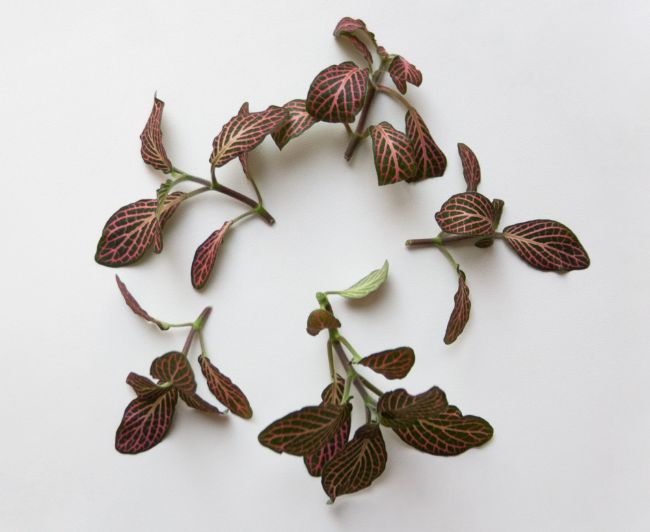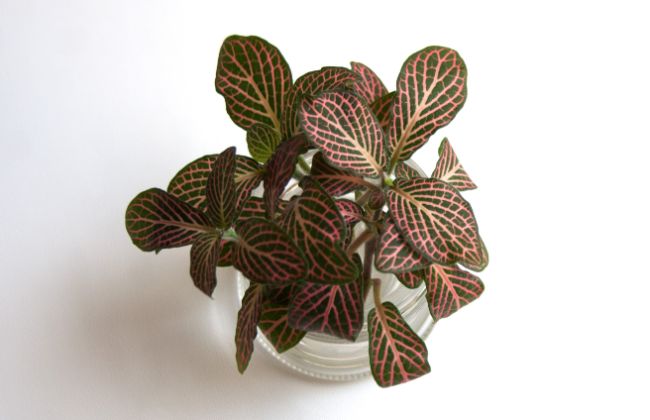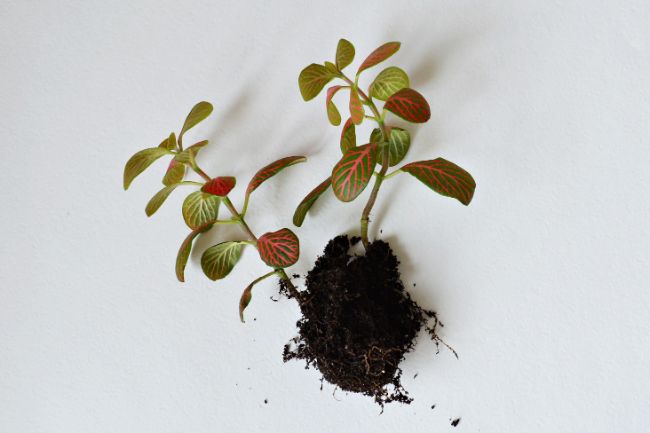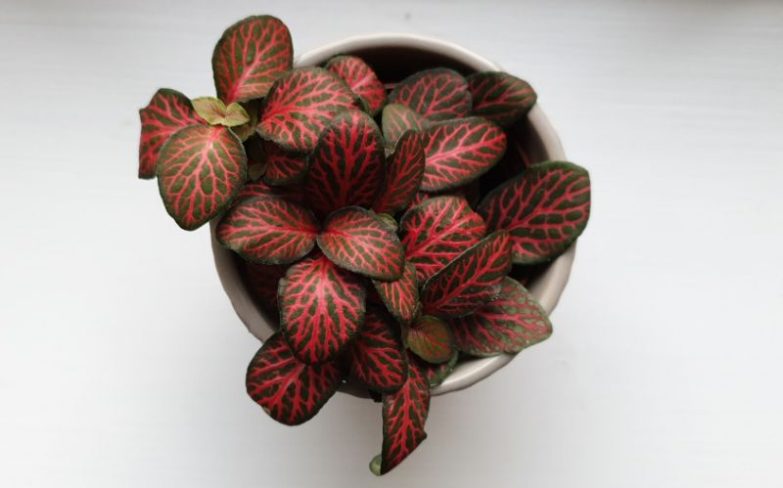As far as houseplants grown for their foliage are concerned, there are few that match Nerve plants (Fittonia albivenis) for their beautiful and delicate little leaves. This article is will provide a step by step guide to Fittonia propagation to help you multiply your collection.
Fittonia propagation is best done by taking stem cuttings and propagating them in water or soil. They can also be propagated from seed, but this is slower and more difficult. Fittonia plants are easily propagated but require high humidity, consistent moisture and bright, indirect light to improve the success rate.
A Guide To Fittonia Propagation
A happy Fittonia will have a cluster of healthy green leaves, veined throughout with its characteristic white, red, yellow, or pink colored lines. It is these eye-catching lines from which the plant draws its common name of Nerve Plant.
There are many reasons to take cuttings. You may want more plants for your own collection or because you want to have them as gifts to give away to friends. Because they are so striking, there will be no shortage of willing takers. It may just be that your original plant is looking a bit tired or leggy and a new start is needed.
I’ve written a few other articles which might help you with Fittonia propagation. I have a care guide covering all aspects of looking after Fittonia plants and a more general guide to propagating houseplatns, which covers the subject in depth.
When To Propagate Fittonia
Spring is the ideal time to take cuttings and grow some new plants to expand your collection. Although cuttings can be taken throughout the warmer months, spring and early summer are when the Fittonia starts to push out lush new growth which lends itself to further propagation.
How To Propagate Fittonia Plants

Preparing Your Cuttings
- Take a careful look at the plant from which you intend to take cuttings.
- You are looking for healthy shoots with plenty of vigorous growth.
- Longer stems are preferable, as you will strip the bottom few leaves from the cutting.
- With scissors or sharp pruners, snip off enough for your purposes but not so many as to leave the parent plant looking too denuded.
- Remove the leaves from the bottom inch (2.5cm) of the stem.
- In the case of cuttings with many leaves, remove excess leaves so that you are left with just one or two leaf pairs at the tip of the stem. This will reduce the risk of excess transpiration causing the cutting to wilt.
Propagating Fittonia Plants In Soil
- Prepare a number of small plant pots or seed trays for your cuttings. A general-purpose houseplant potting mix or combination of 2/3 peat with 1/3 perlite is a good option.
- Pre-soak the potting mix so it is lightly moist.
- Make small holes about half an inch deep for your cuttings in the potting mix with a pencil or skewer.
- You may wish to dip the cuttings in rooting hormone. This can increase the propagation success rate but isn’t essential.
- Gently insert each cutting into the potting mix and firm it around the base of the stem.
- Cover each pot with a glass jar or plastic bag to create a highly humid environment. This will help reduce water loss and wilting and improve the chance of your plants rooting successfully.
- Place your cuttings in a bright, warm location, out of direct sunlight.
- Check your cuttings every few days to ensure the soil remains lightly moist.
- If you see any mold developing on the soil surface or leaves, leave the plant open to the air to reduce the humidity level.
- Your Fittonia will develop strong roots and start producing new foliage within about 4 weeks.
How To Propagate Fittonia In Water
Propagating Fittonia Plants in water is roughly equal in effectiveness, compared to propagating them in soil. The advantages include being able to see the roots growing, and having a better idea when they are ready to be potted on. I find they are less likely to wilt when propagated in water, but the growth rate tends to be a little slower.
- Prepare your cuttings as outlined above.
- Choose a container for your cuttings. A glass, jar, or glass bottle are good options. A water propagation rack makes things very easy if you are planning on propagating plants regularly.
- Fill the container with tepid water. If you live in a hard water area, you may have more success using rainwater or distilled water.
- The base of the cuttings should always remain immersed. If the water level starts to drop simply top it up so that the base of the stem is always submerged.
- Place the cuttings somewhere warm, in bright, indirect lighting. There is no need to cover your cuttings grown in water as local humidity will be increased by the standing water evaporating.
- If the water gets cloudy or algae starts growing, replace it with fresh water.
- Once there are lots of new roots and some foliage growth, you can repot the cuttings into separate pots.

Can You Propagate Individual Fittonia Leaves?
An individual leaf can be propagated in water or soil, but the success rate is lower than using a stem cutting. Make sure to cut the petiole where it meets the stem to make is easier to plant in soil or position when water propagating.
In the case of an individual leaf, you can simply hang it on the edge of a small glass container so that the stem is immersed in water. Alternatively, gently insert the cut end of the petiole into the soil and treat the same as a cutting planted in soil.
Does The Parent Plant Need To Have Been Healthy?
Providing there is enough healthy material on the original Fittonia plant to take healthy cuttings, it is perfectly feasible to take cuttings from a plant that is in decline or suffering from a disease in some of its other leaves. In fact, if you were to see early signs of health problems, then one way of ensuring you did not lose your Fittonia altogether, would be to grab a few quick cuttings.
I would recommend keeping those cuttings separate from other cuttings to ensure that you don’t pass on some disease that you had not yet identified. If the cuttings take well and start to produce healthy new growth, then chances are you have avoided any issues.
Older plants may start to look leggy or generally dishevelled and this would be another good reason to refresh things with a few new plants.
Will Cuttings Be Identical To The Parent Plant?
With this method you are cloning the parent plant and cuttings should have exactly the same traits as the parent plant that they were taken from.
How Long Before I Can Pot My New Cutting?
Cuttings grown in soil or water will start showing fine roots after about two weeks. These will be too delicate to pot up yet but they will continue to grow steadily and after 4-6 weeks should be dense enough for you to pot your Fittonia plant separately.

How Long Before My Cutting Starts To Look Like A Plant?
There are many different types of Fittonia and some grow faster than others so it will depend on the variety you have chosen. As a rough rule of thumb, you should have a respectable looking plant within 2-3 months of propagating.
Other Common Fittonia Propagation Methods
Another Fittonia propagation method is to take heel cuttings rather than cutting your leaves off with scissors. A heel cutting involves tearing the leaf stem away from the plant and taking with it a small part of the parent stem which looks a little like a heel. This can then be grown in water or directly into the soil, depending on which method you favor.
Although the heel cutting method provides the cutting with a greater surface area from which to produce new roots, it also does some damage to the remaining stem of the parent plant.
If this was a plant that you were planning on keeping alive you may want to bear this in mind. If, however, you had already made the decision to sacrifice the parent plant for some reason, then this method will provide healthier cuttings.
Can I Grow Fittonia From Seed?
Some varieties of Fittonia will produce flowers, but the primary reason for growing these plants is their delightful foliage. Whilst it is possible to grow new plants from seed, the delay when compared to growing from cuttings just doesn’t make the effort seem worthwhile.
Also, you need to consider the fact that many of these plants are cultivars and new plants may not come true to form. In other words, the new seedlings may not produce all of the same characteristics that the parent plant offered.
What About Aftercare?
Once your cuttings have been potted up, the soil needs to be kept moist but not soggy. The easiest way to ensure this is to allow the top of the soil to dry out slightly between waterings, but never to let the deeper soil become dry.
By simply poking your finger into the growing medium, you will be able to tell if the deeper soil is still moist. Coming from the rainforests of Peru, these plants like bright light but not direct sunlight and they thrive with plenty of humidity. A north-facing windowsill is ideal.
Feed them once a month with a balanced fertilizer and in the cooler months, you can reduce this regime to once every six weeks. They don’t like too much water but just to be difficult, they don’t like to be too dry either. Luckily, they are quick to complain if they become thirsty and they do this by exhibiting drooping leaves. If you keep an eye out for this you will have time to respond with a quick watering if the need should arise.
Last Word
Fittonia propagation is easily done by taking stem cuttings and propagating in water or soil. Providing, bright, indirect light, high humidity, and consistent moisture will improve the success rate greatly.
If you’ve been struggling with any aspect of houseplant care, or if you just want to grow more beautiful houseplants that stay healthy year after year, check out my book, Houseplants Made Easy. It covers everything you need to know about houseplant care and provides a step by step guide to caring for 50 of the most popular houseplants.

